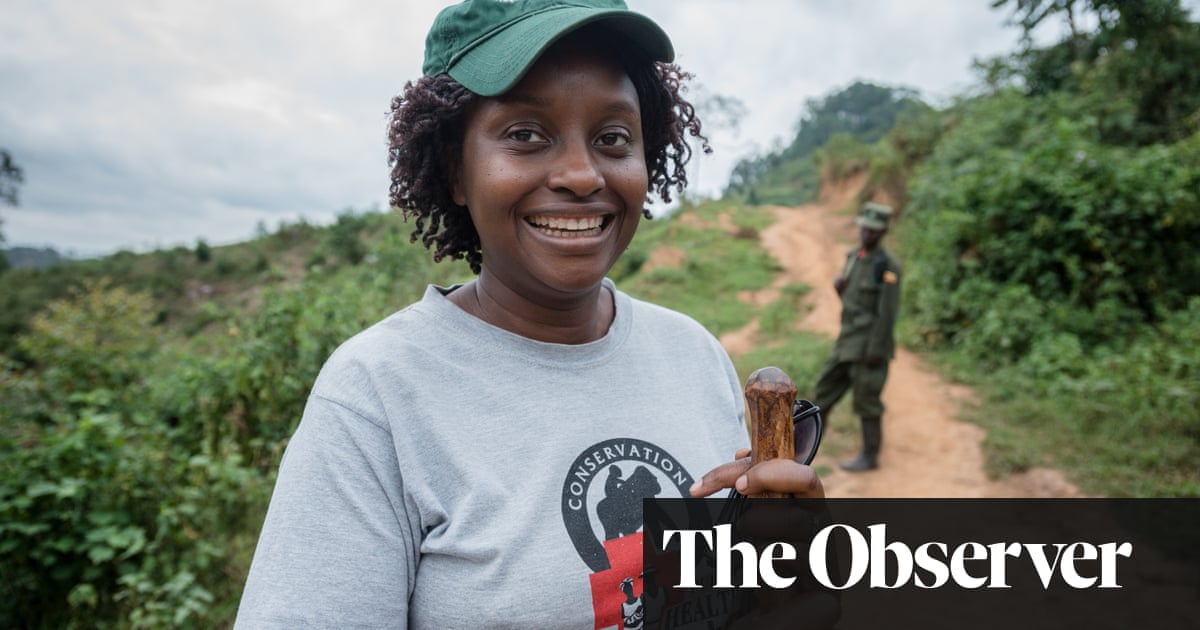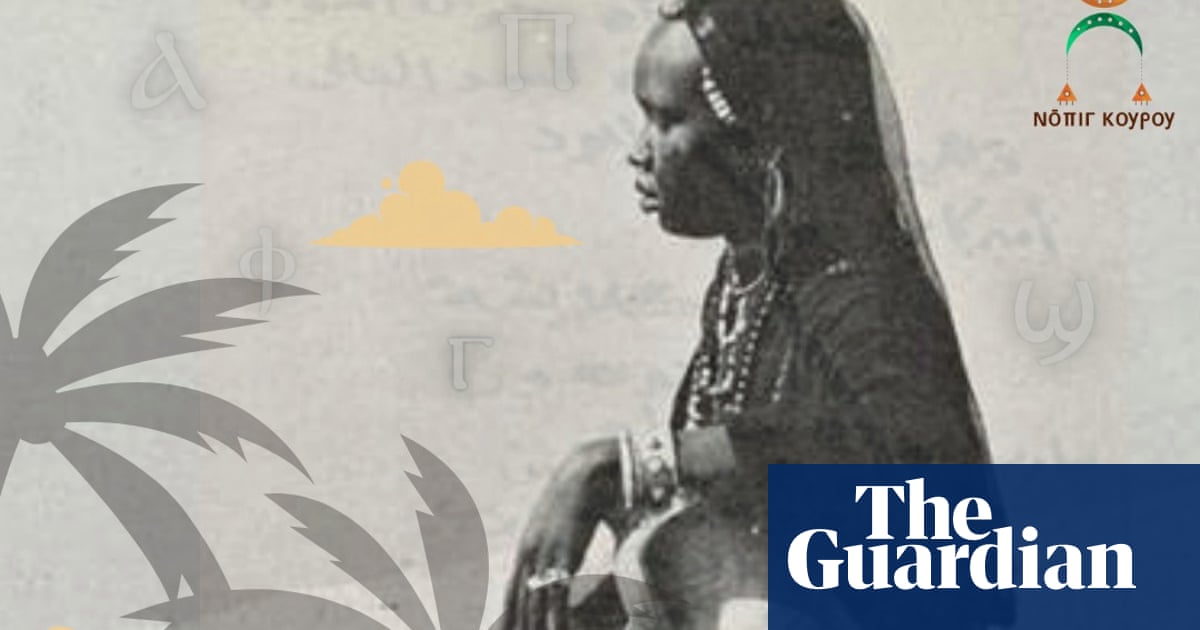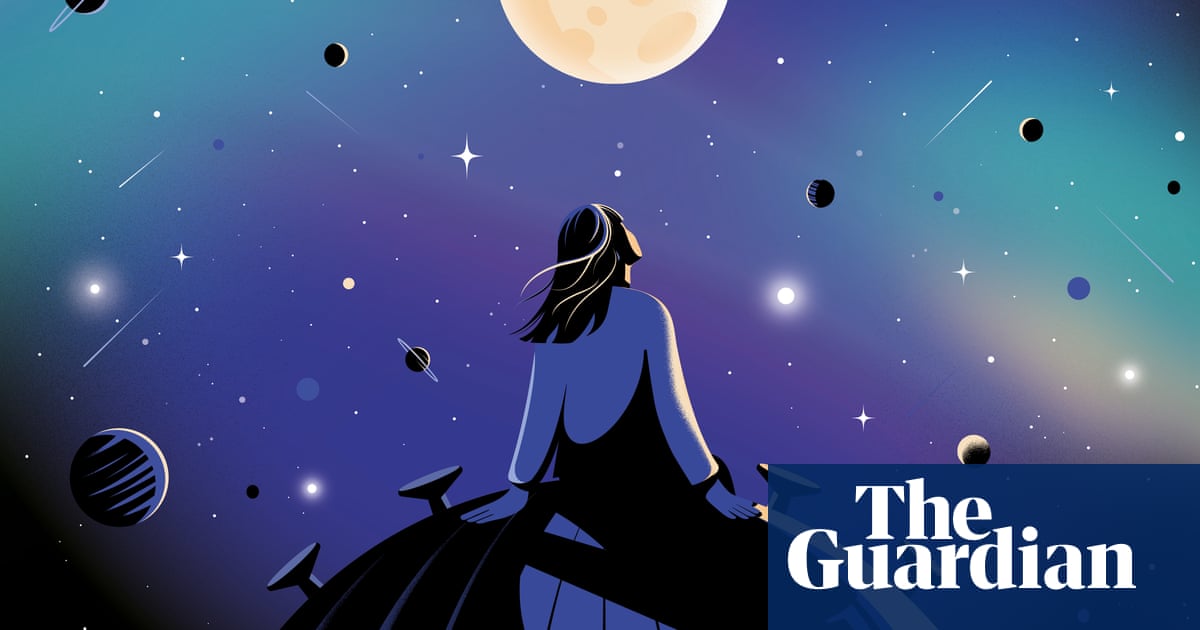
Leo, an 18-year-old rook, is playing mind games. It’s a street-corner classic – cups and balls. Only this time the venue is the Comparative Cognition Laboratory in Madingley, Cambridge, and the ball is a waxworm. Leo – poised, pointy, determined – is perched on a wooden platform eager to place his bet. A wriggling morsel is laid under one of three cups, the cups shuffled. Leo cocks his head and takes a stab. Success! He snatches the waxworm in his beak and retreats to enjoy his prize. Aristotle, a fellow resident donned in a glossy black feather coat, who has been at the aviary almost as long as the lab itself, looks on knowingly.
Watching alongside me is Professor Nicola Clayton, a psychologist who founded the lab 22 years ago, and we are joined by Francesca Cornero, 25, a PhD researcher (and occasional cups and balls technician). Clayton, 59, who is short, with blonde hair, large glasses and is wearing loose, black tango trousers, studies the cognitive abilities of both animals and humans, but is particularly known for her seminal research into the intelligence of corvids (birds in the crow family, which includes rooks, jays, magpies and ravens). Corvids have long proved to be at odds with the “bird-brain” stereotype endured by most feathered creatures and her lab, a cluster of four large aviaries tucked behind a thatched pub, has paved the way for new theories about the evolution and development of intelligence. Thanks to Clayton’s own eclectic tastes, which span consciousness to choreography (her other love, besides birds, is dance), the lab also engenders a curious synthesis of ideas drawn from both science and the arts.
For Clayton, who has hand-reared many of the 25 jays and four rooks that live at the lab herself, the birds are like family. She introduces me to Hoy and Romero, a pair of Eurasian jays, and greets her test subjects with affection. “Hello, sweetpeas,” she says, in a sing-song soprano. “I love you.” Hoy responds by blowing kisses: a squeaky mwah mwah. Many corvids, like parrots, can mimic human speech. One of Clayton’s fondest memories of the lab is when a young Romero said: “I love you,” back. To Clayton, the Comparative Cognition Lab is more than just an aviary, or a place of scientific research. It’s a “corvid palace”. And having presided over it for more than two decades, Clayton, undoubtedly, is its queen.
But all is not well in her kingdom. Last year she learned that the lab would not have its grant renewed by the European Research Council. Her application had been made amid the turmoil of Brexit and Clayton believes she is now among a growing number of academics facing funding complications as a result of the UK’s departure from the EU. The pandemic has only exacerbated the challenge of finding alternative financing. And while the university has supported the lab in the meantime, at the end of July, this money is also due to cease. Without a benefactor, Clayton’s lab is on borrowed time. The corvid palace faces closure. Her clever birds, released or rehomed. A lab that has transformed our understanding of animal cognition – and continues to reveal new secrets – soon may no longer exist. “Obviously, I’m emotionally attached,” she says, looking fondly up at Hoy and Romero, “so showing people the birds at the moment is very difficult.”
In many ways, humans have always suspected something was up with corvids. As Clayton puts it: “You wonder what’s going on behind that beady eye, don’t you?” These birds are shrouded in mysticism and intrigue. Corvids feature prominently in folklore, often depicted as prophetic, tricksters, or thieves. Ravens keep the Tower of London from falling down, and we count magpies to glimpse our fortune. In his poem of the same name, Edgar Allan Poe chose a raven – a talking bird – to accompany his narrator’s descent into madness, and few images are quite as ominous as the conspiring flock of crows gathering on a climbing frame in Alfred Hitchcock’s The Birds. The semiotics of corvids are rooted in an innate sense that the birds are intelligent. Here, Clayton has been able to test some of the true reaches of their mental capacities.
One of the big questions for her concerned “mental time travel” – the ability to remember the past or plan for the future. “People assumed this is something that only humans have,” she says. “That animals didn’t have these experiential memories that require us to project the self in time.” Clayton had already found that scrub jays showed evidence of episodic memory – remembering not only where, but when they had hidden food. But, at Madingley, she observed that jays were also capable of thinking about the future. A study conducted with Dr Nathan Emery, a fellow researcher in animal cognition (and her husband), found that a jay with prior experience as a thief was more cautious when hiding its food – if a thieving bird knew it was being watched when it was caching, it would move the food to a new hiding place later. Birds that had not previously stolen food for themselves remained blissfully ignorant. It seemed that jays could not only relate to a previous experience, but put themselves in the eyes of another bird and make decisions based on the possibility of future events. The results of the study were published in Nature in 2001. It was, Clayton says, a “gamechanger”.
Another experiment at the lab conducted by Chris Bird, a PhD student, drew on the rich cultural heritage of corvids for inspiration. Its starting point was Aesop’s fable, The Crow and the Pitcher. The study found that – just like the “clever crow” – rooks were capable of manipulating water by dropping rocks in it until food was raised within reach of its beak. Another experiment found that rooks – which don’t use tools in the natural habitat – could use their creativity to make task-specific tools, such as bending wire into a hook to lever a small bucket out of a tube. “I always had a big respect for birds,” Clayton says. “But I was stunned by how intelligent they were.”
Studies such as these have helped establish that animals which followed a different evolutionary path to humans were in fact capable of intelligent thought – that intelligence evolved independently in separate groups. To Clayton, corvids are as intelligent as chimpanzees, and her research into these “feathered apes” has shaped the thinking of many academics in the field. Henry Gee, an evolutionary biologist and a senior editor at Nature, told me that Clayton has proved that intelligence has nothing much to do with how brains are wired, or even how big they are. “She has shown that corvids are capable of a ‘theory of mind’. They can conceive of themselves as agents in their own lives. They can plot, plan, scheme and even lie, something human beings cannot do until they reach the age of about three. In other words, corvids think very much like we do.”
As news that the lab faces closure has rippled through the scientific community, the reaction has been of sadness and dismay. An open letter signed by 358 academics from around the world has called on the university to reconsider. One signatory, Alex Thornton, a professor of cognitive evolution at Exeter University, said it would represent an act of “scientific vandalism and monumental self-sabotage”. Gee said it showed a “lack of intelligence”. Emery told me that creating something similar somewhere else would be pretty difficult, “if not impossible”, and incredibly expensive. “These birds cannot be purchased ‘off the shelf’,” he said. “If Nicky’s corvid lab closes down, then it couldn’t really start up again.” As the letter states, the lab at Madingley is the only one of its kind in the UK, and remains “globally unique in its size and capability”.
For Jonathan Birch, an associate professor at LSE, it is this years-long approach that makes Clayton’s lab so significant. “I see some big cultural problems in science as it is now, with a focus on the short term,” he told me. “All around the world, not just in Cambridge, this is squeezing out funding for long-term studies. Clayton’s lab shows us a different way of doing animal research: an approach where we see animals for what they are – sentient beings with their own individual lives to lead. And where we study them over the long term to find out how they think and solve problems. The international significance of the lab is hard to overstate. Its closure would be a terrible loss to the sciences of mind and brain.”
In a statement, Cambridge University praised Clayton’s work, but said that continued investment was “not sustainable at a time of rapidly rising costs and when funds could otherwise be allocated to support the research of early- and midcareer academics”. It added that it would be “delighted” to work with an external funder to keep the aviaries open, should one emerge in the next few months. It is hard to put a precise figure on what it would cost to keep the lab open in the long run, but Clayton estimates it could cost £300,000 to £500,000 to secure the birds for another five or six years. She has received some partial offers from potential donors, though nothing has been confirmed.
Clayton’s work remains pivotal in changing how we think about animals. As the New Scientist reported, studies conducted at her lab are “part of a renaissance in our understanding of the cognition of other creatures… but there is still much more to learn”. And to learn from animals in this way is a slow process. These sorts of experiments, says Clayton, require years of preparation. You can’t just teach any old crow new tricks (well, perhaps you can, but it wouldn’t be scientifically valid). The corvids cannot be wild caught, as researchers would not know the prior experiences of the bird. For these sorts of experiments, the birds must be handraised in controlled conditions. It also takes considerable time to build up the trust required to run an experiment. “It’s a privilege,” says Clayton, “to get the opportunity to see inside their minds, and for them to trust us enough to share what they know with us.”
Cornero, who is researching how rooks understand language, tells me that it took a year before she could start working effectively with Hoy. She has now taught him to respond to a number of verbal commands. When she says, “Come,” he comes. When she says, “Speak,” he mumbles something in corvid. It raises further questions about our assumptions of which animals we consider “smart”; if a rook can be trained much like a dog, then is domestication really a prerequisite to “intelligent” behaviours? “In the context of conservation and the climate disaster,” says Cornero, “I think it’s really important for humans to be increasingly aware that we aren’t the only ones that think and feel and exist in this space.”
If anyone is equipped to bring these ideas into the public consciousness, it’s Clayton. She has always had a knack for creating tantalising work – for nurturing a creative frisson around different ideas, approaches and perspectives. For inspiring new thought. She is the first scientist in residence at the Rambert School of Ballet and Contemporary Dance and has a long-term collaboration with the artist Clive Wilkins, who is a member of the magician’s circle (and her tango partner).
“Magic reveals a lot about the blind spots we have,” says Clayton, and lately magic has opened up a new line of inquiry for the lab. Last year, a study led by Elias Garcia-Pelegrin used magicians’ sleight of hand as a means to test the perceptual abilities of jays. You don’t have to be an evolutionary biologist or an expert in animal cognition to find these experiments alluring.
Much like a magic trick, this research leaves you with more questions than answers, but now Clayton is reluctantly preparing her birds for departure. The younger birds are being readied to be released into the wild. The others have all, thankfully, been found suitable homes; and the rooks may continue their lives at a similar research lab in Strasbourg. Really, Clayton remains hopeful that the lab will find some way to continue its work. Since she could walk, she says, all she ever wanted to do was “dance and watch the birds”. It’s not easy to let go of what she has built here. As we stand in the aviary, listening to Hoy chirp, “What’s that noise?”, I ask her what it really means when a corvid mimics a human phrase, or a jay says, “I love you”. “Well,” says Clayton, “It’s their way of connecting, isn’t it?”












